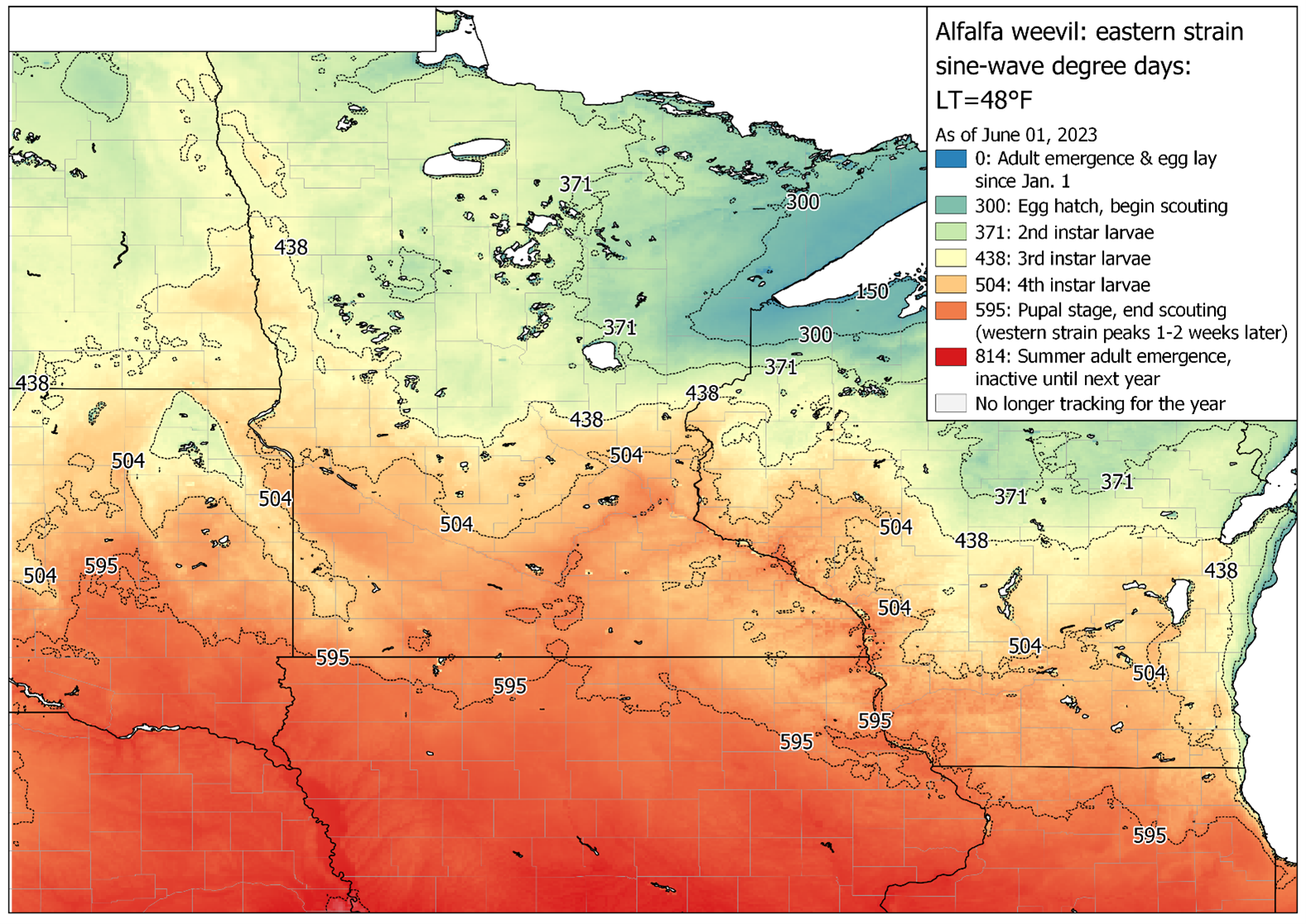June 2023
By Anthony Hanson, Regional Extension Education - Field Crops Integrated Pest Management
During the past few years in west-central Minnesota, calls have been coming in throughout June about heavy defoliation in alfalfa fields. If you produce hay, but haven’t heard of alfalfa weevil yet, consider yourself lucky. You don’t want to be caught off guard by it though. Sometimes growers don’t notice a problem until after their mower is covered in green weevil larvae. Be out scouting your alfalfa fields in June for alfalfa weevil or the damage it causes (Fig. 1). Alfalfa weevil is typically a first and sometimes second-cutting pest for those on a three-harvest schedule. It’s been manageable in the past, but new strains in the area and potential insecticide resistance mean it’s time to update recommendations for the control options we have left.
Figure 1. Bare strips from alfalfa weevil feeding under windrows near Morris in late-June 2022. After mowing and until baling, weevils that survived mowing are concentrated and protected under windrows where they feed on early regrowth and can cause stunting.
Alfalfa weevil goes through one generation per year in Minnesota where adults emerge in the spring and lay eggs in alfalfa stems during May. Adults cause very little feeding damage and are not a target for any management strategies, but the green larvae that hatch from their eggs can cause significant defoliation and a window-paning appearance on leaves. Once those larvae reach the end of their development in June, they will eventually develop into adults that go into reproductive dormancy during summer and won’t lay eggs until next year.
Similar to crop degree-days, we can predict roughly when the damaging life stages will be out in the field and when scouting should occur (Fig. 2). As of June 1, 2023, the eastern strain of alfalfa weevil (generally considered MN’s predominant strain) should be ceasing to feed near the southern border of the state with that stage occurring in central MN about a week later if temperature forecasts hold. However, the new challenge, especially in western MN, is what appears to be an extended weevil season with damage sometimes still occurring up to very early July. This is likely due to a western strain of alfalfa weevil that’s been slowly moving east from western states. This strain lags behind about one to two weeks later than the eastern strain. For updated alfalfa weevil development maps, visit https://vegedge.umn.edu/alfalfa-weevil.
There are more in-depth scouting and threshold guides at MN Crop News to determine if an insecticide treatment is warranted or if mowing early may be better choice. Keep in mind that insecticide options are limited. There have been multiple reports of pyrethroids failing to control alfalfa weevil across the state in previous years. This may be due to application issues, but resistance is a major suspect here. Pyrethroids may be on their way out, so the only remaining insecticides groups are mixtures of organophosphates (group 1) or oxadiazine (group 22). Do not apply the same group number within the same year to a field, and avoid applying the same insecticide group the following year so the few remaining insecticides are not lost to resistance. Organic growers may be able to try spinosyn insecticides, but these can be costly and have lower efficacy near 70% control. The reality is that there are not many flexible insecticide options left for this pest.
Another option that may help producers with weevil issues is to transition away from planting solely alfalfa. Alfalfa-grass mixes can reduce weevil densities, but this option is going to be highly dependent on livestock needs. This is just a personal observation, but I have been closely watching my own family’s alfalfa-orchardgrass fields that we grow for our beef cattle. At least during the last three years, we’ve been close to treatment thresholds each year, but not quite reaching them before populations dropped for the year. That’s not a controlled experimental observation, but I do often find myself wondering how much higher the weevil numbers might have been if we were still running dairy cattle and had pure alfalfa stands instead.
With the other primary options being limited insecticides and timing mowing for management, forage producers may need to weigh long-term options like planting mixtures more heavily if they continue to face alfalfa weevil issues.
For more information on identification and current management recommendations on alfalfa weevil there is a recent article on MN Crop News.

